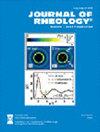流动流体的拉伸流变仪。第一部分:OUBER,一种优化的单轴和双轴拉伸流变仪
IF 3.2
2区 工程技术
Q2 MECHANICS
引用次数: 2
摘要
“六臂交叉槽”装置的数值优化产生了几个三维形状的流体通道,这些通道在具有四个入口和两个出口(两个入口和四个出口)的约束下近似于理想的单轴(双轴)驻点扩展流和牛顿蠕动流。采用Oldroyd-B模型和Phan-Thien模型和Tanner模型进行的数值模拟证实,在恒定粘度和剪切稀化粘弹性流体的几何结构中都观察到最佳流场。该几何结构被命名为优化的单轴和双轴拉伸流变仪(OUBER),通过选择性激光诱导蚀刻熔融二氧化硅衬底实现高精度微加工。采用折射率匹配的粘性牛顿流体,微层析-颗粒图像测速技术可以测量停滞点周围大量体积内的流场。在低雷诺数(<0.1)下进行的流速测量证实了期望和预测流动的准确施加,在停滞点周围的广泛区域内,以基本均匀的变形率施加纯拉伸流动。在本文的第二部分[Haward et al., J. Rheol. 67, 1011-1030(2023)]中,使用OUBER几何形状的压降测量来评估稀释聚合物溶液的单轴和双轴拉伸流变,并与使用优化形状的交叉槽拉伸流变仪在平面拉伸中进行的测量进行比较[OSCER, Haward et al., Phys]。科学通报,2009(1):1 - 3。本文章由计算机程序翻译,如有差异,请以英文原文为准。
Extensional rheometry of mobile fluids. Part I: OUBER, an optimized uniaxial and biaxial extensional rheometer
Numerical optimization of a “six-arm cross-slot” device yields several three-dimensional shapes of fluidic channels that impose close approximations to an ideal uniaxial (biaxial) stagnation point extensional flow under the constraints of having four inlets and two outlets (two inlets and four outlets) and for Newtonian creeping flow. One of the numerically designed geometries is considered suitable for fabrication at the microscale, and numerical simulations with the Oldroyd-B and Phan-Thien and Tanner models confirm that the optimal flow fields are observed in the geometry for both constant viscosity and shear thinning viscoelastic fluids. The geometry, named the optimized uniaxial and biaxial extensional rheometer (OUBER), is microfabricated with high precision by selective laser-induced etching of a fused-silica substrate. Employing a refractive index-matched viscous Newtonian fluid, microtomographic-particle image velocimetry enables the measurement of the flow field in a substantial volume around the stagnation point. The flow velocimetry, performed at low Reynolds number (<0.1), confirms the accurate imposition of the desired and predicted flows, with a pure extensional flow at an essentially uniform deformation rate being applied over a wide region around the stagnation point. In Part II of this paper [Haward et al., J. Rheol. 67, 1011–1030 (2023)], pressure drop measurements in the OUBER geometry are used to assess the uniaxial and biaxial extensional rheometry of dilute polymeric solutions, in comparison to measurements made in planar extension using an optimized-shape cross-slot extensional rheometer [OSCER, Haward et al., Phys. Rev. Lett. 109, 128301 (2012)].
求助全文
通过发布文献求助,成功后即可免费获取论文全文。
去求助
来源期刊

Journal of Rheology
物理-力学
CiteScore
6.60
自引率
12.10%
发文量
100
审稿时长
1 months
期刊介绍:
The Journal of Rheology, formerly the Transactions of The Society of Rheology, is published six times per year by The Society of Rheology, a member society of the American Institute of Physics, through AIP Publishing. It provides in-depth interdisciplinary coverage of theoretical and experimental issues drawn from industry and academia. The Journal of Rheology is published for professionals and students in chemistry, physics, engineering, material science, and mathematics.
 求助内容:
求助内容: 应助结果提醒方式:
应助结果提醒方式:


